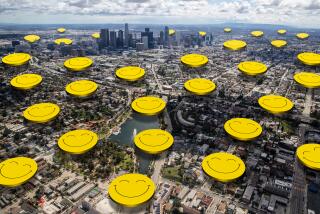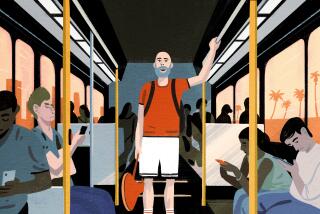COMMENTARY : Union Plaza: An Art Ticket to Nowhere
The recent announcement of artists selected to participate in the public art program at Union Station Gateway Plaza, which upon completion will become the central transportation hub for the entire metropolitan region, was a huge disappointment. The chosen projects are mostly mediocre, hardly reflecting the pivotal importance of the site. A surprisingly narrow range of artists was considered--and selected--for the project, and the winning designs represent severe problems in the current conception of public art.
Architecturally, Union Station is one of the great treasures of Los Angeles. Incorporating offices and retail space, the enormous development that will surround it to the north, east and south will create a critical nexus for automotive, bus and rail transportation in the area.
Gateway Plaza, which is being constructed for the Rapid Transit District by Catellus Development Corp., will rise to the east and will be the principal entrance to the hub’s bus and subway system. The idea is that, from here, you’ll have public transit access to just about any place in the county.
Public art is intended to be integral to this newly developing transit hub, even though it wasn’t added until after the architectural program was completed. Conceived independently of similar art projects throughout the Metro Rail system, it nonetheless takes its place among those already underway as part of the city’s burgeoning mass transit network. Together, they add up to the largest and most far-reaching public art program in the nation.
At Gateway Plaza, three sites for public art had been determined in advance: the main automotive entrance, which was conceived as a landmark to be visible from the nearby 101 Freeway; a so-called “gateway to East L.A.,” at one prominent corner of the development, and a string of five bus shelters in the heart of the plaza.
At more than $1 million, the sizable art budget for the project, expected to open in 1995, begins to approach the civic importance of the enterprise. What is startling is the apparent shallowness of the pool of artists deemed appropriate to the challenges of so major a task. Astoundingly, artists already executing contracts for public art projects at other prominent locations throughout the region’s vast new mass-transit system were also chosen for all three designated art-sites at Union Station.
The selection process, conceived by Tamara Thomas of Fine Arts Services Inc., was a juried, open competition, national in scope. Any American artist could submit credentials for consideration by the jury, which was composed of one artist, a magazine editor and seven administrators.
Some 225 applications were received. Only 50 came from out of state, and only about a half-dozen of those were from artists of national reputation. The applications were winnowed by the jury to nine, from which four artists or artists’ teams were chosen. Not one artist from beyond Los Angeles was counted among the finalists.
The four winning designs were made by a total of 12 individuals--one sculptor and three artists’ teams (two of the teams include architects). The sculptor and one team tied with their proposals for the East L.A. gateway site, so the jury decided to integrate both proposals, in slightly modified form.
Five artists who already have commissions for various sites in the Metro Rail network, including collaboration on the design of neighborhood stations, are distributed among the teams chosen for all three Union Station sites: Peter Shire, who is on the East L.A. gateway team; Kim Yasuda and Torgen Johnson, who are on the team designing bus shelters, and May Sun and Richard Wyatt, who are on the team designing the entrance landmark.
If the enormous development of mass transit in L.A. has created the single largest and most prominent public art program in the nation, are there really that few artists in the region, never mind in the whole United States, who have the capacity to create compelling works of public art for Gateway Plaza?
Is the national art world and its local branch, which both seemed to have grown to gargantuan proportions, and which appeared to be embracing considerable diversity while shaking off entrenched parochialism, in fact a tiny place in which an even tinier local contingent of appropriate “public transit artists” has been carved out?
These queries would likely fade into oblivion, had the projects chosen for Gateway Plaza been superlative. As the selection process came up with mediocrity, however, you begin to wonder if, unconsciously, blandness was desired. For in the occasionally volatile world of public art, some insurance against potential aesthetic controversy might come from hiring artists who are already laboring in nearby fields. They’re tried and true.
The one thread of continuity among the winning designs is a trite conception of public art as some sort of rudimentary, three-dimensional history book, complete with dull texts and labored illustrations. Gateway Plaza’s art is “Dick, Jane and Sally Discover Themselves Through Mass Transit.”
In the bus shelter design, by the team of Yasuda, Johnson, Noel Korten and architect Matthew C. Vanderborgh, historical texts about L.A. and its citizens will be imbedded in paving and railings, while chrome drinking fountains will be etched with multiethnic faces, in which yours will be reflected.
The shelter shapes are essentially a merger of inverted parasols and aerodynamic wings, mounted on vine-covered columns. Over-intellectualized, with such dubious rationalizations as the drinking fountains recalling L.A.’s historic water-wars, the scheme mostly evokes the showy, festival look of standard World’s Fair architecture.
For the entrance landmark, Sun, Wyatt and architect Paul Diez chart a similar path. A tiled patio will show painted faces representing several ethnicities, while another text articulating the demographics of the city’s original pueblo will spiral out and up a flight of stairs, leading to a long, narrow, walk-in aquarium, stocked with fish indigenous to the Los Angeles River.
Architecturally, it’s boring. The idea of looking out at the city through fish-laden water is also unoriginal: In the late-1970s, artist Terry Schoonhoven conceived a well-known apocalyptic mural of downtown under water, apres le deluge , while in the late-1980s the notorious (but inventive) commission for the ill-fated West Coast Gateway, meant to be L.A.’s equivalent to the Statue of Liberty, included an aquarium suspended over almost exactly the same stretch of downtown freeway that will be seen from the entrance landmark.
Finally, extensive text is absent from the geometric sculptures scattered along the terraced stairs at the East L.A. gateway site--gateways apparently having become a favored civic metaphor in recent years--but they are covered with yet more painted tiles, these representing random images and patterns said to be of importance to the artists.
Shire, Elsa Flores, Roberto Gil de Montes and Donna Okeya made watercolors, all working on the same sheet of paper at once, and these random jumbles will decorate the concrete pillars, pyramids, posts-and-lintels and spheres. The ensemble is an achingly elementary articulation of Cultural Building Blocks.
The project also gives us a clear example of today’s charged and polarized outlook on multiculturalism and art. Multiculturalism is nowhere explicitly mentioned in the art project’s brochure, but it’s everywhere implicit. The most obvious is in its urgent plea for artists who reside in East L.A. to apply for commissions--an entreaty that stops just short of declaring a residency requirement--specifically with ideas for the designated gateway site.
Formally, Michael Amescua’s chosen design is quite beautiful. The patterns he created for a fence and gated entry to the plaza derive from papel picado , a Mexican folk tradition of cut tissue paper used to decorate Day of the Dead altars and other festival sites. Imagine an elaborate, wrought-iron fence in flat, black designs, some abstract and some depicting lizards, goats, cactuses, stars, moons and other natural and mythic objects, and you’ll have some idea of how it looks.
You’ll also have an idea of an underlying assumption of the gateway concept, for beauty is not its only feature. It’s safe to assert that had Amescua based his design on, say, beautiful Islamic tiles or Russian avant-garde graphics, rather than modern Mexican folk art, he would never have been selected for the Union Station project, even though he does in fact live and work in East L.A.
What the RTD/Catellus concept for the gateway to East L.A. says, and what the jury enthusiastically supported, is this: Latino artists should make art based on Latino themes, largely for consumption by people of Latino heritage, who cannot be expected to respond to anything else. In a conservative and unwittingly condescending way, for both artists and audiences, anything else is deemed unworthy of patronage.
Diversity is not promoted by such narrowly restrictive thinking. Indeed, homogeneity is what ends up being championed. It’s ironic that the artist proposed to build a fence at the gateway to East L.A., since--culturally speaking--that is precisely what will be constructed.
Printing texts and scattering recognizable faces and historic symbols around buildings do not, in themselves, create “a sense of place,” as many of these artists blithely claim in their proposals. Instead, the program for Union Station Gateway Plaza represents a thoroughly bureaucratic transformation: Public art is here just publicity art--an unchallenging, circumspect, cheerfully bland species of promotion, meant to help sell a civic project to an indifferent constituency.
Well, fine, if that’s what you really want. But, if you do, why not just hire the proven pros at Disney and be done with it?
More to Read
The biggest entertainment stories
Get our big stories about Hollywood, film, television, music, arts, culture and more right in your inbox as soon as they publish.
You may occasionally receive promotional content from the Los Angeles Times.











